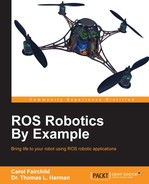This chapter introduced the TurtleBot robot and described how to load the necessary software for TurtleBot. The Gazebo simulator was used to show the capability of ROS to control TurtleBot.
To control a real TurtleBot and allow it to roam autonomously, it is desirable to set up a wireless communication between a remote computer and the TurtleBot's netbook. The explanation given in this chapter will allow you to set up the network and remotely control TurtleBot.
The various methods to control TurtleBot were presented. Teleoperation from the remote computer is one of the common methods used to control the robot's motion. A Python script was shown, which, when executed, will make the TurtleBot move in a straight line. This chapter also covered the use of rqt tools to send commands to TurtleBot and monitor them.
An important aspect of this chapter is that the TurtleBot can be controlled in simulation or in a real environment with the same commands and scripts. This use of a simulator can save much time in planning, testing, and debugging the applications for TurtleBot before the real robot is turned loose.
Odometry for the TurtleBot was described for the simulated TurtleBot and the real TurtleBot using rviz for visualizing the robot's motion. Finally, the auto-docking feature of TurtleBot was demonstrated.
The next chapter explains TurtleBot's use of the vision sensor. The chapter shows in detail how to create a map for TurtleBot and enable it to autonomously navigate around its environment.
